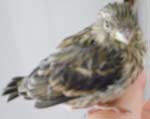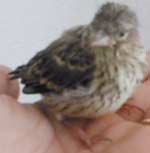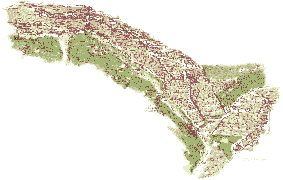Birds, Bees and HoverfliesMonday, 24th June 2002, West Yorkshire |
![]()
![]()
![]()
![]() Rocks |
History |
Workshop |
Links |
Home Page
Rocks |
History |
Workshop |
Links |
Home Page
![]()
 I found these baby shrews when I disturbed a shrew's nest in the compost heap back in June 1999. Since their world is amongst the grass stalks I don't see much of shrews. Although they're a protected species - you need a special license to trap and handle them - this doesn't of course protect them from cats. Cats don't eat them, they are said to be distasteful, so the one that I saw lying on the pavement today had probably been caught and killed by a local cat then abandoned in disgust.
I found these baby shrews when I disturbed a shrew's nest in the compost heap back in June 1999. Since their world is amongst the grass stalks I don't see much of shrews. Although they're a protected species - you need a special license to trap and handle them - this doesn't of course protect them from cats. Cats don't eat them, they are said to be distasteful, so the one that I saw lying on the pavement today had probably been caught and killed by a local cat then abandoned in disgust.My e-mail is dominated by unasked for junk mail but today I have three enquiries which are of more interest.
A Bird in the Hand
 'I have been searching on Google to try and find some information on linnets and came across your site,' writes Alexandra Wilmot from Spain, 'I have found a baby bird, which my Grandfather had identified as a linnet, and have been trying to ascertain whether or not it should be released into the wild or would be better kept in captivity once it is old enough to go out into the big wide world alone.'
'I have been searching on Google to try and find some information on linnets and came across your site,' writes Alexandra Wilmot from Spain, 'I have found a baby bird, which my Grandfather had identified as a linnet, and have been trying to ascertain whether or not it should be released into the wild or would be better kept in captivity once it is old enough to go out into the big wide world alone.''We have been feeding it on a diet of crushed seed (flour form), bread and milk (not an ideal diet I know), and it seems to be coming on in leaps and bounds. It's also very tame, and entertains itself by flying onto our arm and shoulders shouting for food!!! We found him on Saturday morning in the middle of Almoradi town in Spain, and he still seems full of beans, so I am hoping that our care for it up until now has been good. He is quite adept at flying, but only for short periods of time, but has quite obviously flown his nest (or breeders cage) just a few days too early.'
 'As you can see, he is as hand tame as they come, and has been since the day I found him. Makes me think that he either escaped from one of the market stalls, or made a leap for freedom from one of the locals' cages that they put out on their flat balconies. I've only just managed today to entice him into eating the food from the spoon, but he still sits there with his mouth wide open demanding it be put in for him 99% of the time, so I suppose we will have to continue with that for a while.'
'As you can see, he is as hand tame as they come, and has been since the day I found him. Makes me think that he either escaped from one of the market stalls, or made a leap for freedom from one of the locals' cages that they put out on their flat balconies. I've only just managed today to entice him into eating the food from the spoon, but he still sits there with his mouth wide open demanding it be put in for him 99% of the time, so I suppose we will have to continue with that for a while.'I reply that I've shown the pictures to Jill, our next door neighbour who keeps birds, and she says it reminds her of a canary. Jill says that she would keep the bird. She thinks wild birds learn some of their survival skills from the parents and feels that a hand-reared bird might not survive in the wild. But she admits she's soft.
I'm hopeless at looking after birds so if it was a wild bird I'd release it, feeling that I'd done what I could by rearing it, but I'd accept that it might not survive long in the wild.
It's still a bit young to be sure of its identity and I couldn't guess what it is.
'I agree with the hand rearing theory,' Alexandra replies, 'as he certainly knows where to get his food now. As we don't know whether or not it was wild to begin with, I think it would probably be safer to keep it. I'd hate to think of the poor little fellow out there without a clue as to where to sleep and how to feed itself. See, I'm soft too!!!! Incidentally I hand reared a baby sparrow that was only a few days old (totally bald, pink and scrawny, with little grey spikes where his first feathers were starting to come through) about 10 years ago, and that little fellow survived until my mother left one of the lounge windows open during one of his exercise sessions. It flew out the window never to be seen again. But at least it survived a bit longer than it would've done if I hadn't found it, and who knows, maybe made a go of things in the wild.'
She says that she'll keep me posted on how things go.
The Swarm
Helen McKenzie of Linlithgow, Scotland, writes children's stories that are wildlife based.
'My stories are small adventures for the 6 - 7 age range,' she tells me, 'My main character Annie loves to explore her Grampa's garden, and finds herself shrinking to the size of whichever creature she encounters, and helping them to solve a problem.'
In Annie and the Queen Bee we get to explore the inside of hive and learn about honey bee dances and navigation. We meet Bonny, a worker bee with attitude, who takes a dim view of the laid-back attitude of the drones. The story comes to a climax with a bee's eye-view of a hive preparing to swarm.
- a very deep hum . . . echoed through the hive. Others began to join in, until there was a huge clump of bees, all humming and marching their way out of the hive.
'We must go!' ordered the Queen. 'Follow me!'
She led the way outside the hive. Annie blinked in the bright sunlight, and then gasped - hundreds of bees were flying around, swooping and weaving in the air. Annie could not imagine how they did not bump into each other!
The Queen and Annie flew up to the top of the hive.
. . . All at once the huge swarm of bees settled onto a nearby branch, massing together so tightly that they looked like a black and yellow football.
I've only once seen honey bees swarming, in a front garden a couple of doors up the road. It's an impressive sight, even if you haven't been shrunk down to half an centimetre in height.
Will the bees find a new home without driving Grampa from his garden shed? I won't spoil the story for you. Let's hope Helen finds a publisher soon.
Helen's father is a keen photographer, specialising in Scottish landscapes. His work can be seen at www.sunnyside-studio.com
Mason's Marks
 Finally there's a historical question;
Finally there's a historical question;'I visited Sandal Castle yesterday,' writes Jenni, 'and noticed some interesting carvings on the entrance to the archway under the curtain wall. They are like a K shape with what looks like a right angle symbol in the neck of the K. Do you have any idea what this represents?'
'Well spotted,' I reply, 'I presume that this is a medieval mason's mark. I looked around for some to include in my booklet but didn't spot any and I guessed that most had been obscured or worn away since the excavations. The masons got paid per block so it was important for them to use a distinctive mark. I believe the archaeologists worked out how many masons were working at any one time, how they were organised into teams, where each team worked and how they were supplied with beer and bread.'
'But that took years of excavations; Channel 4's 'Time Team' would have done all that in 'just three days'!'
My Sandal Castle book was published last autumn.
![]()
Richard Bell,
wildlife illustrator
E-mail; 'richard@willowisland.co.uk'
![]()
Next page |
Previous page |
This day in 2000 |
This month |
Nature Diary |
Home Page
![]()